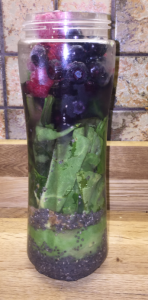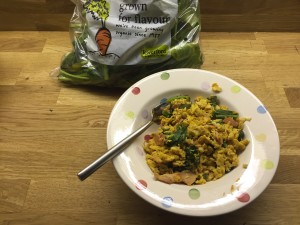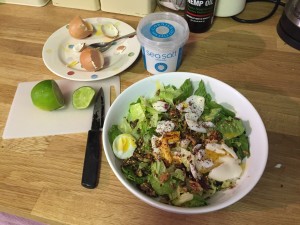Easy Ways to Add Vegetables to Your Diet (even if you don't like veg)
Posted in Articles, Featured on October 30, 2015
I am embarrassed to say that I used to have a terrible diet.
It was bad, like really bad.
I'd consume high volumes of sugar, tonnes of simple carbohydrates and more trans fats that you could shake a stick at. However, arguably worse than all of this is that I ate almost zero fresh fruit & vegetables.
The problem was, particularly with vegetables, that I couldn't stand them. They tasted disgusting and nothing at all like the nice yummy things I was used to; far too crunchy and, well, veg tasting.
If this sounds a bit like you and you also can't stand the taste then there's some good news: it is possible to re-train your taste buds and begin to not only love eating fresh veg but to also get to the point where you actually crave the stuff.
If I can, trust me, anybody can.
The following illustrates the ways that I used to start getting veg into my diet with great success.
Green Smoothies

Chia seeds (pre-soaked), half an avocado, big spoon of organic 100% peanut butter, fresh spinach, some diced celery, a cube of frozen spinach, handful of frozen blueberries & raspberries then filled with water
I'm sorry to break it to you but shop bought smoothies are big sugary drinks.
There are strong arguments (fiercely disputed by manufacturers like Innocent it has to be said) that the industrial processes remove so much of the fibre that it is mostly all gone and you're left with high counts of isolated fructose that'll absorb quickly into your bloodstream just like other sugary drinks (including fruit juice). Like all things in life, having one now & again is no problem but you might want to re-consider if you're consuming drinks like these regularly.
At home the lines get even more blurred (and if anything the arguments get fiercer). One has to be careful to get the facts straight given the amount of Woo out there surrounding most nutrition subjects but my opinion based upon a fair amount of reading is that domestic blenders don't hammer the fruit as much, so you still get a good amount of fibre content and, especially with veg, the blending does you a favour. Breaking the cells down enough that you actually get to absorb a lot more of the goodness than you would if you were to just chew & swallow it whilst eating.
Do your own research but for me there is a compelling argument for using fruits with a lower glycemic index (GI), like berries or apple, to sweeten (read: hide the taste of) a more than 50% vegetable smoothie, thus giving me a healthy vehicle for getting a few of my veg count in before I've left the house. As a bonus I also know exactly what's gone into the drink.
You can get smoothie makers from most electrical retailers. There are expensive ones like the NutriBullet or the one I use is the much cheaper Breville one which is really neat, takes 5 seconds to clean and costs about £25.

Not as disgusting as it looks, honest!
I suggest that you start slowly. Use banana for the base, milk for the fluid and just load it up with fruit, then once you've got the taste start introducing the veg a bit at a time. You might want to also consider adding something like a spoonful of seeds (crushed a bit first), for some 'good' fats as well as more texture. For example most supermarkets will sell you an Omega 3 'sprinkle' bag.
One essential thing is to have some of the contents frozen as this makes it more like a shake and it is definitely more delicious. Berries and spinach will both spoil quite easily when fresh but if you have then frozen then you can just pull out of the freezer what you need on a daily basis.
These days I use water not milk and only a handful of berries. Avocados are awesome for lots of reasons and happen to make a great base. For an extra layer of flavour, and extra goodness, I include a generous spoonful of high quality peanut butter.
I make one at the end of my morning routine and will drink it on the way to work.

Rainbow veg
Roasting
Another great stealth veg method is roasting.
So many types of veg roast well and are really delicious. Squashes, sweet potatoes, courgettes, aubergines and even carrots. You can even make really yummy 'crisps' in about 15 minutes from kale or chard.
My favourite method for a dead easy, fresh meal that can be made on a school night is to chop up whatever we have in the fridge into medium chunks, sprinkle some sea salt and Turkish chilli flakes (very mild) over and roast for about 40 mins. Wrap some fish in foil and put in the same oven 15 mins before the veg are ready and you've got a meal you'd pay £15 for in a restaurant.

Spinach always reduces down a lot
Augmenting eggs
I eat a lot of eggs, 2 or 3 a day usually.
Poached they are really nice but it's a bit of a faff for a week day so I generally go for scrambled.
I'll start by frying up some bacon chopped into bits (I buy rindless if I can) then I'll chuck in some spinach and/or chopped tomatoes before adding the eggs and constantly mixing for a few mins.
It's a really quick meal and with a bit of seasoning you can - if you choose to - pretty much hide the veg.
Salads

A pretty obvious one but it's worth mentioning nonetheless.
I always thought salads were pretty horrible. Some insipid lettuce and a token tomato that I then had to smother in mayo to make palatable.
How come nobody told me that the leaves are simply a substrate?
Apparently everyone else knows that you're meant to use them as a bed only and then add lots ingredients on top. Eggs or meat, cheese, nuts and seasoning transform the basic salad base into really healthy, delicious and, most importantly, filling meal.
My favourite trick is to toast 3-4 tablespoons of the Omega 3 mix over the weekend - this takes < 1 min in a pan - and put them in a jar. I can then sprinkle these over with some lime or lemon juice as a 5 second dressing. Feta cheese is amazing on most salads & for a Mediterranean feel I also normally sprinkle over some Sumac.
Another great salad derivative is salsa. I always thought it was too time consuming to make until I discovered that food processors had actually been invented.
Chuck in, roughly chopped: half an onion, a pepper, 4 tomatoes and - an essential ingredient - some flat leaf parsley as well as a teaspoon of Turkish pepper then pulse for a minute. Transfer to a bowl and add some olive oil and you've got yourself a really lovely side to your main salad that'll keep for a couple of days in the fridge and really impress your friends if you're ever cooking for them. You can also easily spice it up with some Jalapeño.
I'll make a salsa 2-3 times a week.
Give it a go
I feel confident that once you've got started on this path you'll get used to eating healthy ingredients that you didn't use to like and your taste buds will start to change. Like most things, start small, take it steady and give it some time; you'll be amazed at how things might change.
What I have missed?
Do you have any other top tips on stealth veg delivery? Do you blitz veg in the processor and add it to soups or stews for your kids? Got any great recipes? I'd love to hear from you. Pop a comment below.